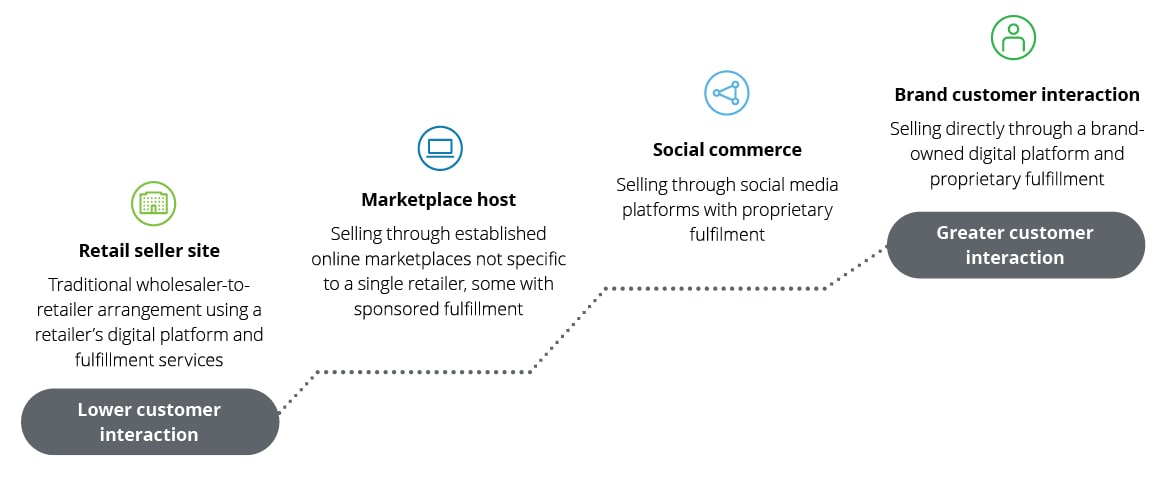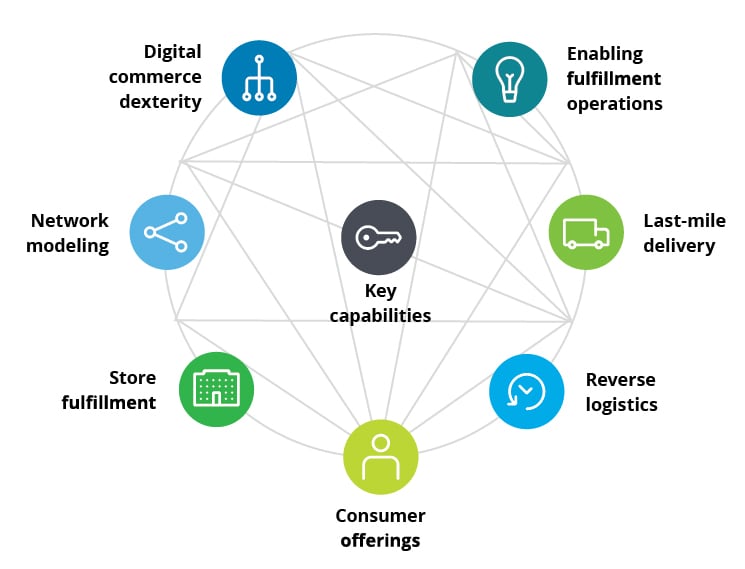Digital commerce transformation has been saved

Perspectives
Digital commerce transformation
Reimagining e-commerce ecosystems and supply chains
The COVID-19 pandemic has fundamentally changed consumer behavior, with an accelerated shift to shopping online. What should wholesalers and retailers consider when adapting their e-commerce ecosystems and supply chains in the “new normal?” Explore the seven key areas essential to successful digital commerce transformation.
Stores are open, but customers are still online
Relaxed restrictions and a pent-up desire to shop for pleasure has increased consumer intent to purchase apparel, footwear, and other nonessential products. However, for the foreseeable future, customers will continue to shop online more frequently. What’s causing the ongoing shift?
- Consumers have become comfortable purchasing additional product categories online. Online grocery shopping tripled during the pandemic.
- Expanded online assortments and new promotional tactics have encouraged customers to start their journeys online.
- Despite distancing and safety measures, almost half of consumers surveyed by Deloitte in August 2020 did not feel safe shopping in a brick-and-mortar store.
- Limited stock and selection in-store is driving consumers online, despite delivery costs and delays. Forty-two percent of consumers are willing to pay for convenience.
In the online world, digital and supply chain capabilities are on display
The heightened consumer preference for online shopping means more focus will be placed on e-commerce services and experiences than ever before. Educated consumers will comparison-shop for services along with products and prices.
Delivery and return policies are the greatest cart abandonment driver. For example:
- Forty percent of customers won’t complete checkout if these costs are too high.
- Ten percent of customers will abandon their cart if a package won’t deliver on time or the delivery time frame is not clear.
- Five percent of customers will abandon their cart if they’re not allowed sufficient time to return products or the wait for a refund is too long.
- Sixty-nine percent of customers will continue to shop with a brand they’ve had an excellent site, delivery, and returns experience with.
When all else is equal, e-commerce capabilities will convert virtual window-shopping into sales.
How will your brand create a digital connection with an online customer?
You can establish a firsthand connection via a traditional direct-to-consumer model or a relay connection using retail and social media partnership models. The key will be determining the right digital commerce model, or combination of models, for your brand and ensuring your ecosystem and capabilities are in place to satisfy the consumer no matter how you reach them. Failure to deliver as promised via any model will ultimately affect your brand.

How will your supply chain be affected?
Warehouses, processes, and systems that were designed to move full cases of products from dock to dock cannot maintain the same levels of efficiency when cases are opened to sell products as individual units. The shift from case-level to unit-level processing will add labor, material, and transportation expenses throughout the product and order life cycles, including:
- Labor for unit-level prep and packing
- Prep materials (polybags and labels)
- Labor to unpack, prep, and put away units
- Replenishment of active pick locations
- Website maintenance and product digitization
- Payment and credit services
- Labor for unit-level picking and packing
- Packing materials
- Small parcel delivery
- Residential or peak volume surcharges
- Higher return rate than in-store purchases
- Delivery costs for mailed returns
- Customer service sites and agents
Based on the average case pack, shifting to unit-level processing results in 24 times more supply chain touches to complete orders. Facility alterations, system enhancements, and new ways of working will be required to maintain expense rates and profit margins.
How will you succeed?
Your digital ecosystem and supply chain must excel in seven key areas in order to support increased sales while maintaining financial performance and service standards.

At a minimum, you must assess your current digital capabilities to understand their maturity and add internal or external support where needed. Opportunity areas include:
• Converting demand through online channels
• Developing an easy-to-navigate site or platform
• Creating and implementing an effective technical platform
• Having an effective merchandising approach
• Understanding the effectiveness of strategies by collecting data across channels
Key digital players have set the competitive bar and consumer expectation for two-day delivery. Network modeling is a powerful tool to achieve this at minimal cost.
SKU segmentation by brand or product type can result in longer delivery times or require expedited carrier service to deliver in two days. However, segmentation based on SKU velocity and consumer demand can allow for delivery to all customers in two days or less using ground service.
Fulfilling online orders in brick-and-mortar stores can improve profit margins by avoiding markdowns in slow-selling locations. Achieving the same expense rate as warehouse fulfillment requires leveraging store strengths.
Stores are designed to maximize the shopping experience. Picking and packing orders in a dynamic environment can increase costs and affect the customer experience.
Stores can be leveraged for single-unit orders; buy online, pick up in-store (BOPIS); curbside pickup; ship-to-store; and warehouse return hubs. Ultimately, customers who cross-shop online and in-store are worth 30% more in lifetime value for retailers.
The shift to unit-level processing will result in 24 times more touches to complete orders. Process inefficiencies and poor use of space or materials will quickly stress the supply chain and compound incremental costs. To address this, consider the following:
• Stocking strategy: SKU allocation based on demand, centralized stocking of slow sellers, and capturing attributes at the source
• Control tower: Order wave management, waveless replenishment, and cyclical inventories
• Automation and IoT: Automated storage, retrieval, and packaging and AI-guided or robotic processes
• Sustainable packaging: Standards and materials that eliminate waste and promote ongoing use
Customer demand for fast delivery, coupled with increased e-commerce volumes, is exceeding the capacity of traditional delivery networks like small-parcel and owned fleets.
Emerging models like independent couriers, crowd-shipping services, and autonomous delivery can be layered into traditional methods to support growth and service performance.
Customers return online purchases three times more often than in-store purchases. Failure to address key return pain points will drive expenses up and dilute the customer experience. This will mean ensuring that policies are competitive and customer-centric and establishing processes to optimize returned merchandise’s value.
Experienced online shoppers know the methods and costs associated with package delivery. Cost-to-serve e-commerce capabilities establish a trustworthy brand and create brand loyalists.
When retailers achieve maximum productivity and throughput, same-day processing, and efficient reverse logistics, they can offer customers free delivery and returns, two-day delivery, flexible return policies, and fast refunds.
Focus on selling the products and brand rather than fulfillment services. Sales growth from increased loyalty and fewer abandoned carts is worth far more than revenue generated from fees.
How Deloitte can help
Deloitte can help retail, wholesale, and consumer products companies realize value quickly and effectively to meet market opportunity today and in the future. Our approach begins with the customer promise and sets the foundation for your future e-commerce ecosystem and supply chain. Deloitte’s digital commerce services can be tailored to accelerate any journey.
Recommendations
Effective pricing strategies during inflation for consumer companies
Measures to control inflation can drive growth over time
Making merchandising and supply chain integration a reality
Unlocking transformation in your retail supply chain




